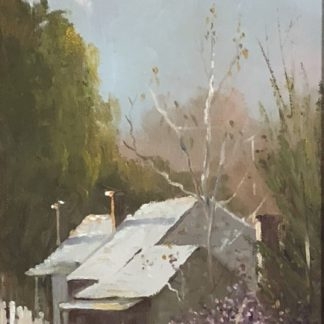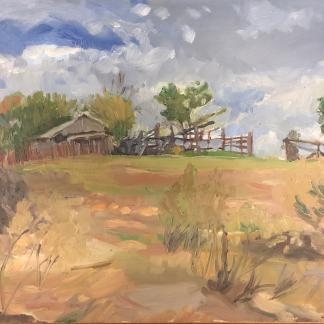Bio
John Thomas Nightingale Rowell (Australian 1894-1973) Bio
John Thomas Nightingale Rowell (1894-1973) and William Nicholas Rowell (1898-1946), artists and stage designers, were born on 18 January 1894 and 29 January 1898 at Carlton, Melbourne, third and fourth sons of George Rowell, butcher, and his wife Margaret, née Nightingale. They were educated at Faraday Street State School, Carlton.
In 1908 John worked part-time at the King’s Theatre, Melbourne, before being apprenticed to a scene-painter. He studied art at West Melbourne Technical School and in evening classes at the Working Men’s College. At the National Gallery School, in 1912-17, under Bernard Hall and Frederick McCubbin he won several prizes. On 16 January 1917 he married fellow student Eugenie Bertha Durran.
After military training in 1916-17 Rowell taught at West Melbourne Technical School and succeeded Harold Herbert as instructor (1919-27) at the art school, Ballarat School of Mines. He then became senior painting master (1929-47) at the school of applied art, Melbourne Technical College. A senior examiner of art for the Education Department, he also illustrated departmental textbooks. In 1937-38 Rowell and his family toured England and the Continent; he was greatly impressed by the works of Corot, Velasquez, Gauguin, Van Gogh, Monet and Turner. While in London, he was awarded a Carnegie grant that allowed him to travel in North America.
With his brother Will, Rowell also produced scenery, sets and costumes for the King’s and National theatres. He was art adviser to the latter and later vice-president of the National Theatre Movement. Rowell’s first one-man exhibition was held in October 1917 in the Upper Athenaeum Hall; many more followed in Melbourne, Adelaide, Sydney and Brisbane. He won the Crouch prize (1927, 1937) and several other awards. He was represented in the 1923 Exhibition of Australian Art in London, and his ‘Monarchs of the Soil’ was selected for the Imperial Art Exhibition, London (1928). He exhibited at the Royal Academy of Arts, London (1936, 1938), and in Paris, Dublin and Glasgow, and was a fellow of the Royal Society of Arts, London (1937), and member of the Royal Institute of Oil Painters, London. He was commissioned to paint the coronation of King George VI.
Rowell was a kindly man, of medium height, slim build, blue-eyed and fair-skinned, with inexhaustible patience, always the thorough professional. He was considered a leading exponent of Australian Impressionism, placing considerable emphasis on technique. His works were influenced by McCubbin, his friend Walter Withers and Max Meldrum, though he should not be considered a Meldrumite. A lover of Nature, he is best remembered for his traditional rural landscapes. A realist, a superb draughtsman, with a strong sense of colour and space and with the tonal vigour of Velasquez and Corot, he used back-lighting to capture atmospheric effects, especially brilliant sunlight. His search for the essence of a subject was influenced by Chinese and Japanese techniques.
Survived by his wife and daughter, John Rowell died on 14 November 1973 at Mornington, and was cremated. He is represented in national, State and regional galleries, and in many private collections in Australia and overseas. Retrospective exhibitions were held at the McClelland Gallery, Langwarrin (1973), and the Mornington Peninsula Arts Centre (1982).
















